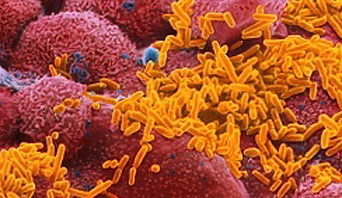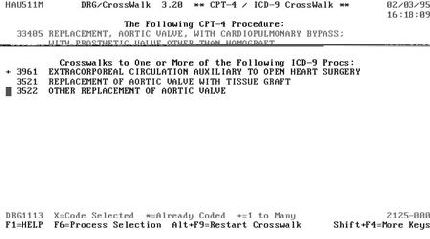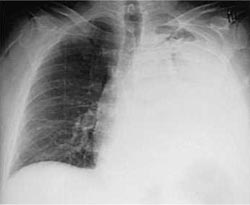Researchers at other institutions around the world reported
similar associations. In industrial poultry or pig farm
were drug-resistant bacteria colonizing agricultural workers
and their families. In 2003 and 2004, Kellogg Schwab
air samples on poultry farms where pigs were placed in 3000
two buildings. Samples contained enterococci, staphylococci, streptococci and
, and 98 percent of bacterial isolates
were resistant to two or more common drugs. In the paper
published in Environmental Health Perspectives
Schwab suggested that one way bacteria
could travel from animals to humans was workers breathing >> << that air. In another study from 2002 to 2004
Schwab samples of surface and ground water and upgradient
downgradient from the pig farm. He and his fellow researchers found
downgradient water, ie water in
stream from swine barn contained 17 times more >> << enterococci, 11 times more
Escherichia coli,
and 33 times more fecal bacteria Escherichia group as water
upgradient from the object. Downgradient
pathogens also were much more likely resistant to antibiotics. Once Bloomberg School colleague down the hall from
Silbergeld returned from the source on the east coast >> << complain about how disgusting it is found to drive behind trucks >> << transportation chicken processing
plants. Silbergeld says, "When someone says:
" disgusting ", I say," Wait, there must be something here
happens. " She and her two students, Anna
Terms and Shawn Evans, intended that they called >> << "Child, you can drive my car," the study. They loaded cars with
equipment for sampling, found that section
on the East Coast near the border of Virginia
is a lot of birds of trucks passing through on the way to
Purdue and Tyson processing plants, and went to the next >> << parking in the center of many shops. Whenever birds >> << truck stopped at a traffic light, the researchers
slide and follow its processors. They then
sample air inside the car and the car
exterior door handles and sealed soda can they fit in
coaster car. They found that air
machine and both surfaces have shown elevated levels of enterococci
once would drive by chicken trucks. Samples received in the car traveling truck
. does not contain resistant enterococci, a quarter
isolate the bacteria after the truck showed resistance
drugs, including tetracycline, erythromycin and streptomycin
This is not only research involved in a car. Jay
Graham, formerly one of the students Silbergeld in degrees, and now
in the U.S. Agency for International Development
studied the waste on the East Coast. He said that every time he returned to Baltimore, his car
was covered with flies, and this led him to wonder if flies
be spraying bacteria resistant
from poultry farms. Graham said Silbergeld, that he wanted to do
research. "I said," This is fine until you
bring no flies here. The next thing I knew we had these
two large banks full of flies in the lab, and I thought, "Yes
thanks for that." Graham flies trapped in poultry farms
on the East Coast and found resistant staphylococci and enterococci
on them. He analyzed how pathogens for
drug resistance genes in bacteria and found matches
taken from flies and bacteria taken from farm waste,
strong evidence that flies are a potential source
influence of bacteria resistant hiding in agriculture
waste. cientists
know that resistant pathogens can travel from farms by air,
water, birds, flies, chicken manure spreader or truck,
but they do not have a good answer as far as they can
travel and how long they can remain viable. Just because a researcher
detection of drug-resistant Staphylococcus aureus in the sample air
not prove that it can make any patient. But
means of transmission, which can cover long distances
, from person to person, an employee of the farm, such as
picks up bacteria in the chicken shed and passes it
family member, which transmits its member communities
which brings him to the clinic or hospital where he
settles and begins to cause antibiotic-resistant infections in
surgical patients with impaired immunity. For years, scientists, doctors and the public
considered more widespread drug-resistant infections in hospital
task (see
Johns Hopkins Magazine, February 2008). This is where dangerous germs as vancomycin-resistant enterococci
(VRE) and methicillin-resistant Staphylococcus aureus
(MRSA) hide and spread. But then
Hospital began to report more and more people
never been in a medical institution that passes through their doors
already colonized by resistant bacteria. Where people
raising error as MRSA, which currently kills more than
20000 people each year, more people than die from AIDS? About three years ago, Silbergeld began thinking about MRSA
and agriculture. It was not the only one. In
November 2006, Dutch scientists reported case >> << A young mother treat mastitis in October 2004. Culture
adopted its general practice showed, MRSA, which
then found her husband and small daughter. Her husband was a farmer
from 8000 pigs, and when the researchers tested
10 selected at random from farms, they found genetically identical
MRSA in eight of them, and the same error in focused on three
other workers from the farm. Otherwise, as well as
Holland, 63-year-old woman was admitted to hospital with MRSA
caused endocarditis. When the researchers introduced
her infection, they found not in accordance with
nosocomial strains of MRSA, or strains causing community acquired MRSA
skin infections in the United States
. What she did match MRSA isolated from Dutch pig farms.
Another study conducted in the Netherlands found the rate of MRSA colonization
among pig farmers be 760 times more >> << general public. A year ago, Canadian research
published in Veterinary Microbiology was the first >> << find MRSA pigs in North America and pig farmers;
scientists studied farms in Ontario and found MRSA In 25 percent of the
experimental pigs and 20 percent of workers
farms, which colonized animals purchase strattera. On farms that were free >> << Colonial pigs, no cases of human disease. Finally, the last
January study by the University of Iowa tests
299 pigs and 20 people from two farms in Iowa and Illinois. The researchers found, MRSA in 49 percent of the animals and << >> 45 percent of people. This was the first such search << >> in the United States, and voltage, ST398, was identical >> << to that found in Canada and the Netherlands. . << >>





